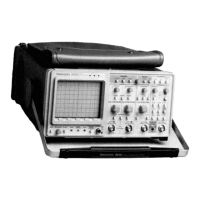Power-on or Self Diagnostics (SELF DIAG) tests that
detect a system, subsystem, or device failure that may
affect instrument calibration are noted by a FAIL label on
the test along with the calibration status of UNCALD in
the EXT DIAG menu display. Calibration failures are of two
types: soft errors caused by gain or offset parameter drifts
beyond tolerance-usually caused by a large change in
Factory calibration of the 2430 is done using NBS
traceable sources. An internal jumper installed at the time
of calibration prevents the user from inadvertently running
the EXT CAL routines and voiding the traceable calibration
of the instrument. Removing the jumper and attempting to
do the ATTEN and TRIGGER calibration without an accu-
rate standard amplitude voltage source will result in a
failed calibration. In the case of a failure, the stored con-
stants for the attenuator gain calibration are not replaced;
therefore, the previous degree of accuracy is maintained
by the instrument. However, a FAIL label remains
displayed over the affected EXT CAL menu choice, and
the scope will fail subsequent power-on tests and enter
Extended Diagnostics (EXT DIAG) until the calibration is
passed.
VOIDING CALIBRATION
Passing the ATTEN calibration step using an NBS
traceable voltage standard ensures that the internal,
nonadjustable 10 V Calibration Reference is also trace-
able. Subsequently passing the SELF CAL procedure
(which uses the traceable 10 V Calibration Reference to
provide the calibration voltages) then makes the 2430 an
NBS traceable instrument. Traceability is maintained for
subsequent performances of SELF CAL by referencing all
calibration calculations to the traceable internal voltage
reference of the 2430.
For the 2430, traceability is established in the Extended
Calibration routine by calibrating the attenuators (ATTEN)
and external trigger amplifiers (TRIGGER) with an NBS
traceable voltage reference. As the fine gain adjustment of
the attenuators is made, the relative accuracy of the inter-
nal 10 V Calibration Reference is also checked by normal-
izing it to the external voltage source provided by the tech-
nician. If the fine gain of the attenuators requires an
adjustment of more than approximately 2%, the ATTEN
calibration fails. Barring 2430 component problems, a
failure indicates either that the internal reference is faulty
or that the applied voltage is not a valid standard refer-
ence voltage.
6-2
Traceability to the National Bureau of Standards (NBS)
requires that the stated accuracy of an instrument has
been established through calibration with equipment
whose accuracies have been established either directly or
indirectly by NBS certified references.
NATIONAL BUREAU OF STANDARDS
TRACEABILITY
Recommended Adjustment Intervals
The recommended interval for doing the Extended Cali-
bration ATTEN and external TRIGGER calibrations is
every 2000 hours, or once a year if the instrument is used
infrequently. Readjustment of the Display System and
rerunning the REPET calibration step will not normally be
needed unless parts are replaced that affect those calibra-
tions. It is NOT necessary to reperform any portion of the
Extended Calibration to maintain maximum measurement
accuracy over the specified operating temperature range
of the instrument.
Dynamic Adjustments
As the 2430 operates, continuous adjustments are
made to correct for minor offsets in the acquisition system
and jitter correction ramp timing. The dynamic adjustments
are totally automatic and require no user action.
Manual Adjustments
Adjustments made by the technician involving access to
the internal portions of the scope are limited to the Display
System, the crt adjustments, the CCD output amplifier
gains, the attenuator input capacitance, the 50 MHz
bandwidth limiter (and 20 MHz bandwidth limiter with the
Video Option), and the charge-coupled device (CCD) sam-
pling clock skew. These adjustments are made during
factory calibration of the 2430 and should not require read-
justment during normal operation. Replacement of parts
during repair of the instrument that affect these calibra-
tions will, however, require readjustment of the affected
circuitry. The ADJUSTS (DISPLAY in version 1.7 firmware)
calibration routine in the EXTENDED CALIBRATION pro-
cedures provides display patterns and brief instructions for
the technician to follow in calibrating the Display System
and CCD output amplifier gains.
samples and the trigger point. That time difference is used
to place the waveform samples correctly with respect to
the trigger point in the repetitive acquisition mode
waveform record.
Maintenance-2430 Service

